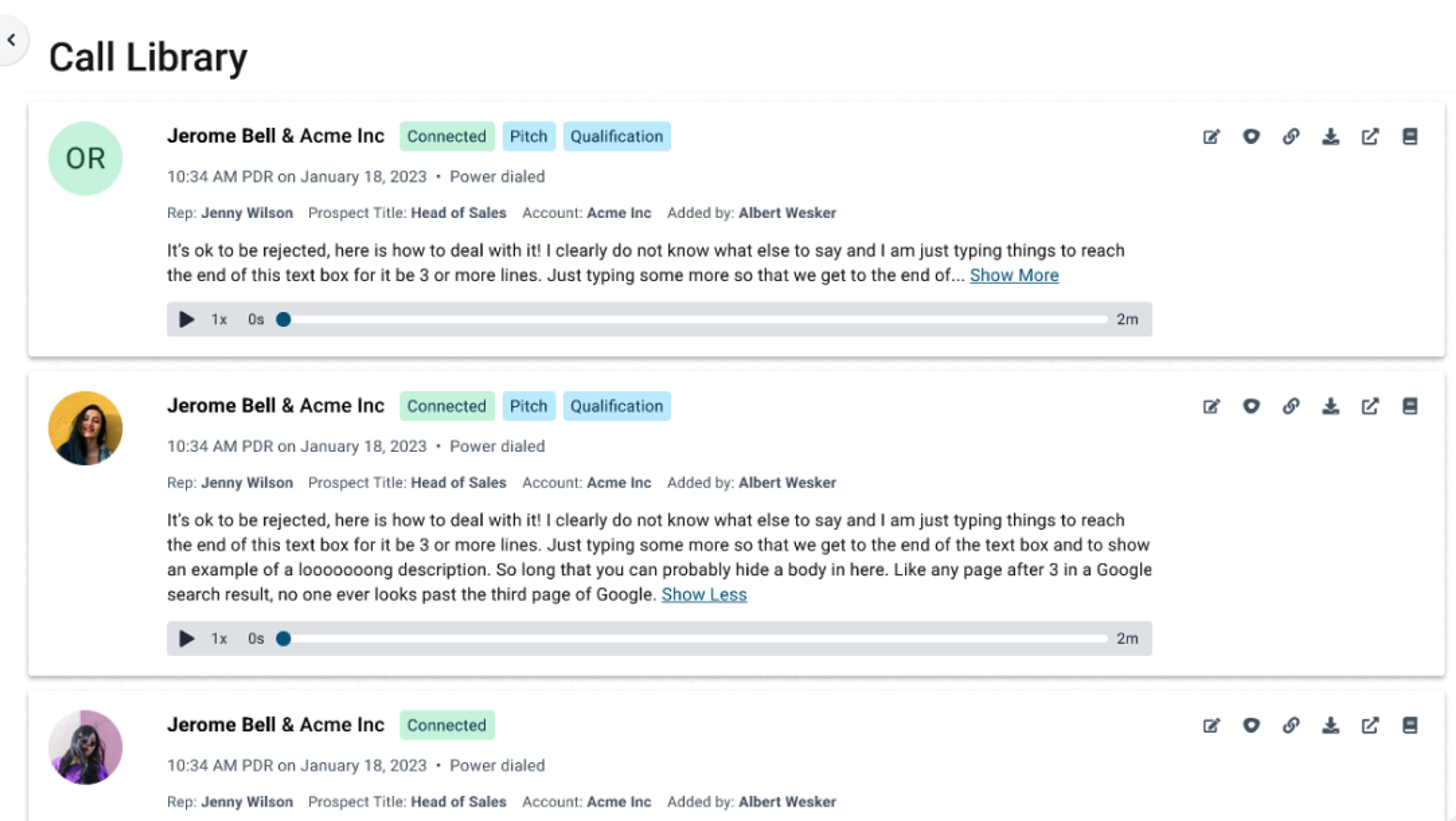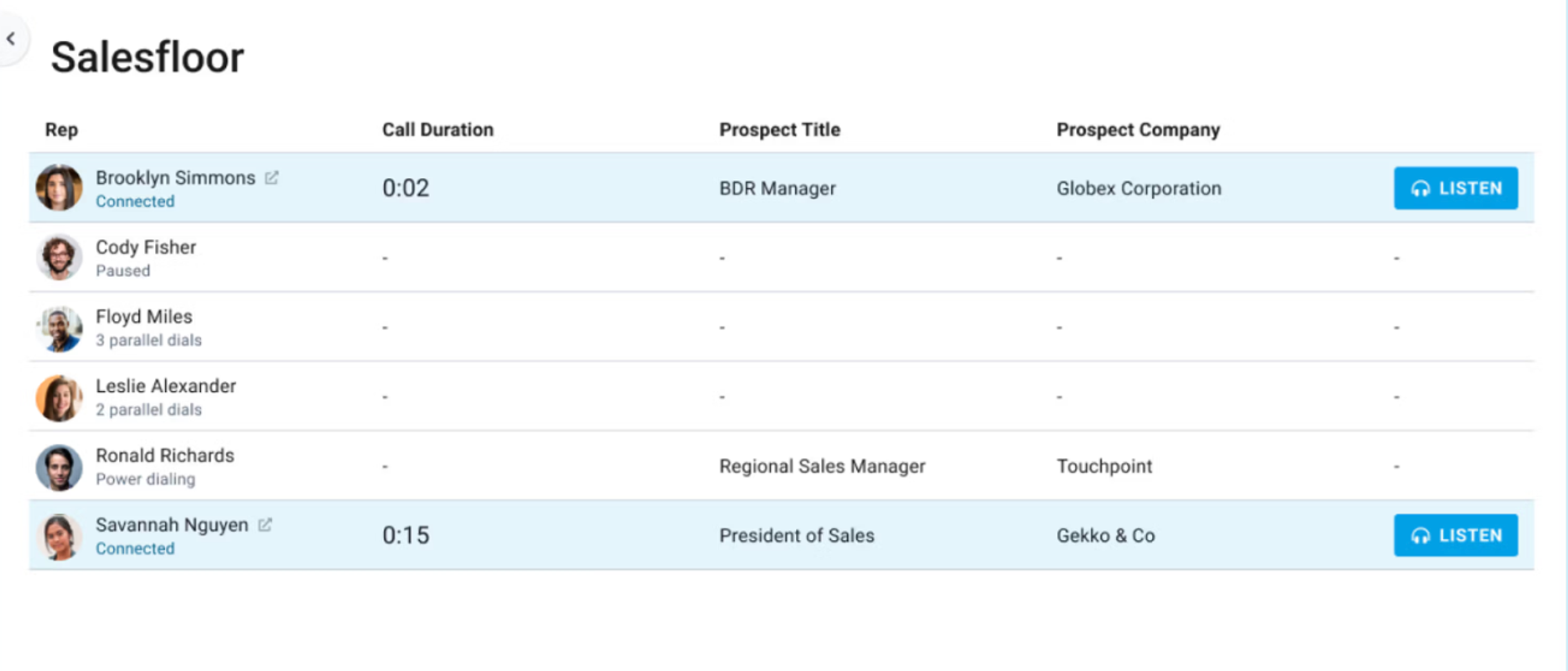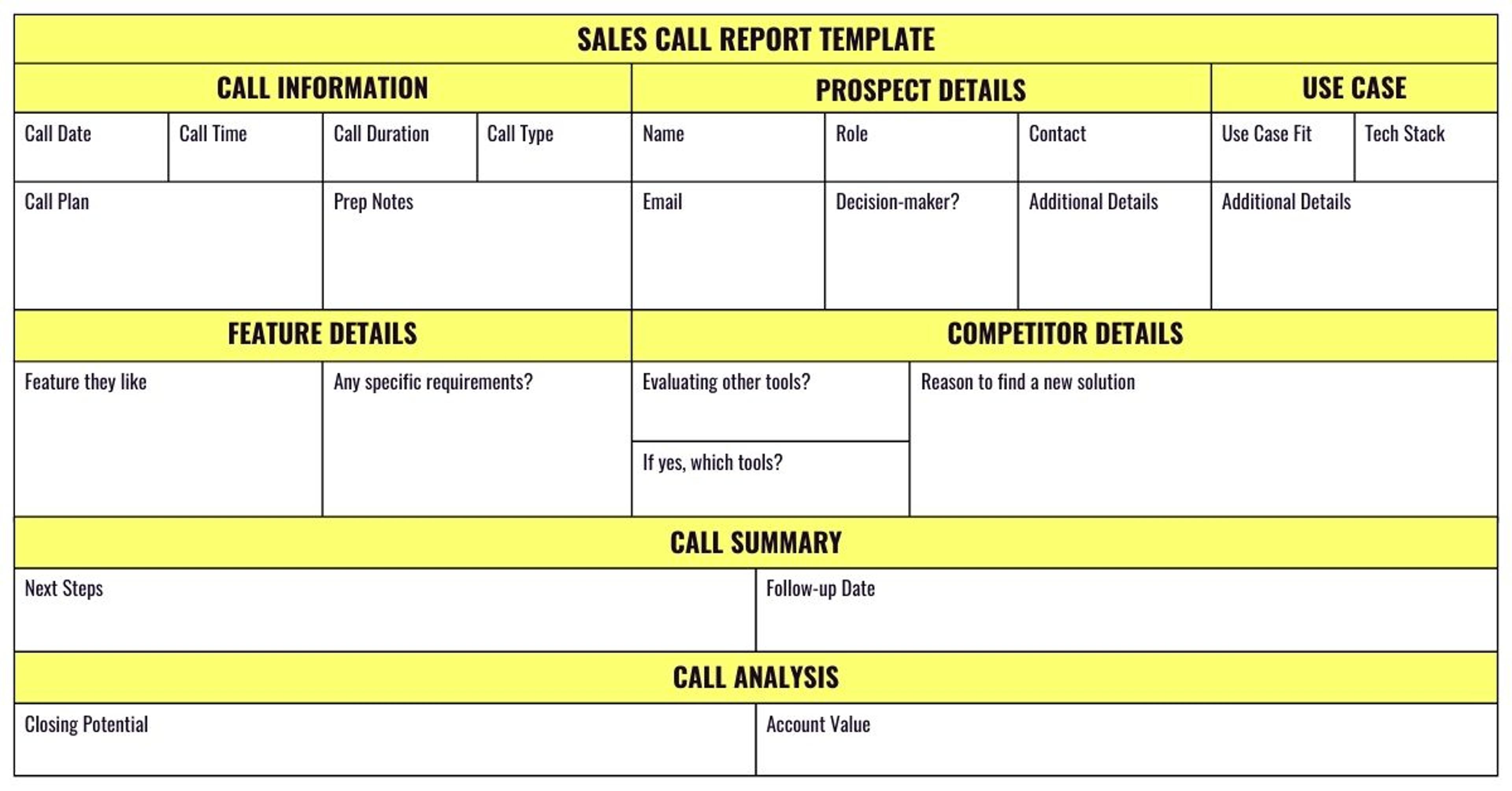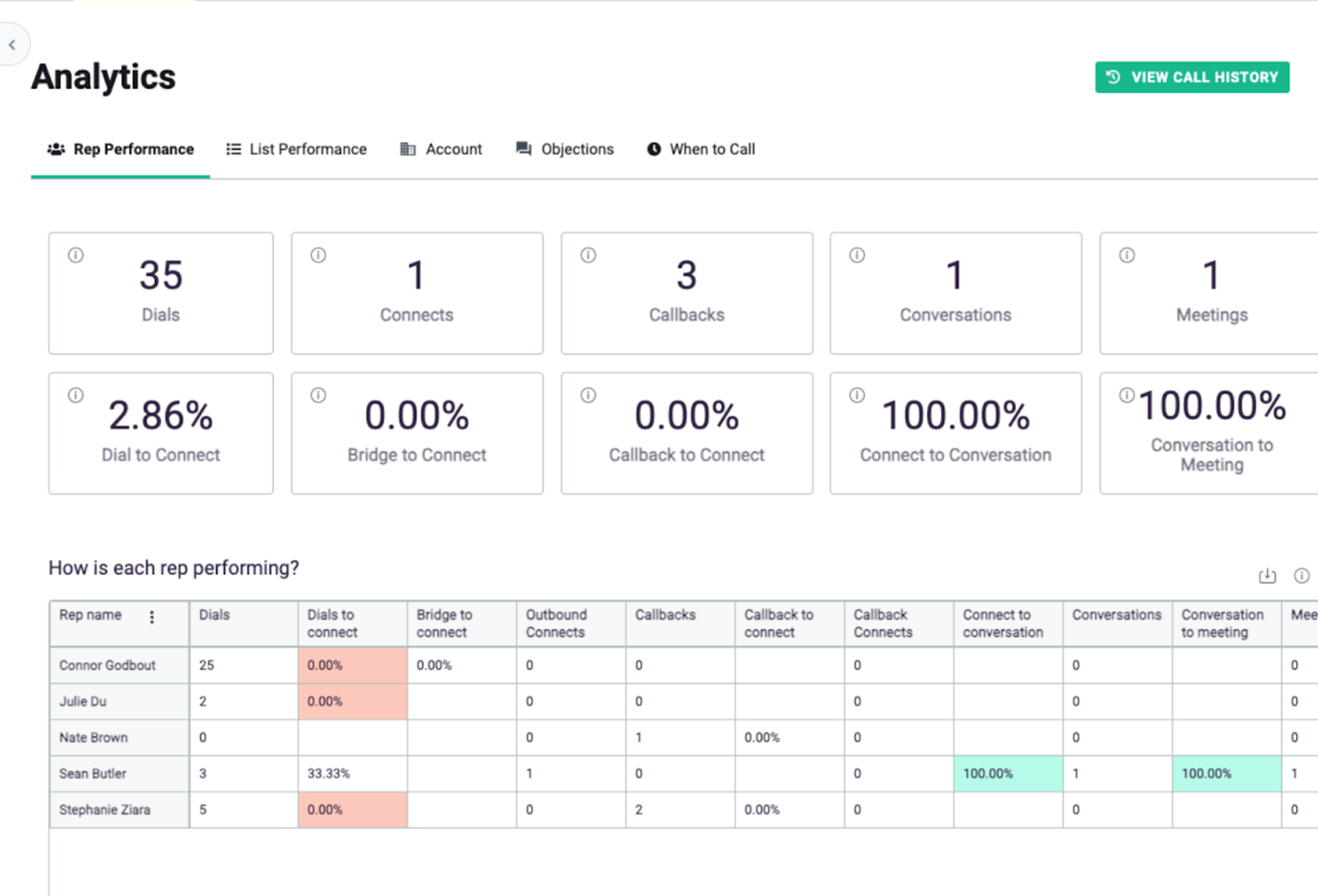Reviewing Sales Calls for SDR Coaching (+ Free Sales Report Template)


For enterprise-level sales managers, sales call reviews are necessary to refine sales activities, improve sales reps' performance, and drive pipeline growth.
But we know the reality—time is tight, and digging through call details to find actionable insights can feel overwhelming. It’s tough to balance coaching with the constant pressure to deliver results.
That’s why this guide includes a free sales call report template to make reviews efficient and impactful. With a clear structure, you’ll spend less time on prep and more time helping your team improve where it matters most.
We talked with Arely Brattin, Senior Sales Development Manager at Orum to bring you practical expert tips.
Looking to increase sales rep productivity?
Know when reps need support, coach them with best-in-class examples, and identify trends early on with Orum.
Request a demo
Why reviewing sales calls is crucial for SDR success
Successful sales managers know reviewing sales calls is more than checking a box. That's why 54% of companies focus pipeline generation on call recording and analytics, according to our 2024 State of Sales Development report. It’s how you develop confident, high-performing sales reps.
Discover how reviewing sales calls can positively impact your sales team and help you increase the number of closed deals below.
Develop sales skills
Sales calls are a goldmine for coaching moments. You can use call summaries to highlight what works and what doesn’t for your sales representatives. Be specific when breaking down techniques (e.g., how to handle objections or guide a prospect toward the next step), so all team members understand exactly how to improve.
💫 Get inspired Tools you use matter. With Orum, Crunchbase saw a 400% boost in call productivity. Easier access to call data and streamlined tracking made it simple to coach individuals and teams more effectively, transforming how they approached every conversation.
Identify areas for improvement
Call reviews illuminate what might be holding your team back—whether it’s missed cues, a lack of clarity in messaging, or low prospect engagement.
It’s important to analyze these moments together and collaborate on ways to improve, shared Arely Brattin, Senior Sales Development Manager at Orum:
“Call coaching is effective in creating enablement–for a single sales rep and your team. Because 99% of the time, your team hears the same objections.”
And the thing sales representatives struggle the most with? Kicking off the conversation right:
“In my experience, sales reps often struggle with their opener. We tend to stick to what we know, but making a micro-adjustment at the beginning of the call often leads to a better conversation. For example, having a permission-based opener has been shown to work.”
You might need to rework the sales process, refine scripts, or practice roleplays for common scenarios. It might take time, but incremental improvements lead to big changes, and that’s how you can adjust your sales strategy: Continuously.
Boost confidence and performance
When sales reps know exactly what they’re doing right and have a plan for what to improve, their confidence improves significantly. Use call reviews to celebrate wins and provide constructive feedback.
Confident reps perform better and contribute to a more positive, high-energy team dynamic. Momentum is contagious, and your team needs to feel well-equipped and motivated to take on their next call.
How to review sales calls for maximum coaching impact
Is it possible to automate sales call reviews? Not entirely, but here’s how you can make the review process much more efficient, according to a sales professional in the trenches.
Structure the review process
A clear structure keeps reviews focused and productive. To understand the flow, start by listening to the full call without interruptions. As you listen, take notes on key moments, e.g., how objections were handled or how the SDR built rapport.
After that, you’ll be able to discuss specific highlights and areas for improvement with the rep and tie feedback to actionable next steps. For best results, you should coach in a team setting and individually, and every session needs to have defined action items afterward.
To make coaching effective, you need to create a healthy coaching culture. Only then will your team members be open to feedback, shared Brattin:
“We set aside time in our weekly standup meetings to review a call together as a team and ask the rep what they think they did well and what can be improved. This opens the floor for the team to do the same. Doing this first thing in the morning is great because it gets their brains working to tackle cold calls right after.”
A healthy coaching culture leads to establishing an effective calling culture. The right tools make a huge difference in this context, and this is obvious in 1:1 sessions, says Brattin:
“During a 1:1, I like to review the analytics in Orum and see what objections my reps are hearing and what their % is for overcoming those objections. If we are struggling with a specific objection, it’s good to make notes in the 1:1 doc to review it together."
Orum’s Call Library stores all sales calls, making it easy to revisit and analyze past calls. SDRs can independently track their progress over time and compare their calls to team benchmarks.

Involve the SDR
Make call reviews a two-way conversation by encouraging SDRs to self-assess first. Ask them to share what they think went well, where they struggled, and what they’d do differently next time. They must develop self-awareness. That’s how they’ll excel in their careers.
Collaborative feedback turns the session into a learning experience they feel invested in, leading to more meaningful improvements. Brattin shared the framework she likes to use:
“I like to ask–what are your thoughts on that call? What did you do well, and what could you have done differently? I really like XYZ from this call, and you mentioned XYZ could have been done differently in that call. Do you mind if I share some tips on how you could do that differently?”
Involve the sales representative and encourage them to take ownership. When you create a psychologically safe environment where feedback is normalized, it’s more likely that they’ll see it as helpful and not take it personally.
Set actionable goals post-review
It’s crucial to turn each review into a roadmap for improvement. As a sales manager, it’s your responsibility to guide the team and set KPIs and North Star metrics. Make sure you identify specific next steps, like refining objection handling, strengthening the opening pitch, or practicing active listening.
It’s important to use data-driven insights from the call to set measurable, achievable goals that the SDR can focus on between sessions, shared Brattin:
“Goals are typically set around call openers, discovery questions, and objection handling. For example, you can set a goal for adding a permission-based opener and limiting the opener to 30 seconds. You can also set the minimum number of open-ended questions or a quantifiable goal for increasing the % for overcoming a specific objection.”
💡 Pro tip
With Orum’s Live Listen, sales managers can jump into calls in real-time and give feedback right when it matters most. It helps SDRs adjust on the spot, turning tough moments into learning opportunities. This kind of quick coaching builds confidence and helps your salespeople improve faster.

Boost coaching with data-driven insights
Data doesn’t just tell you what happened—it shows you where to focus your coaching for the biggest impact. Here’s how you can further improve your team’s performance.
Sales report template for effective reviews and coaching
This free sales report template is designed to help you track key metrics, identify patterns, and measure progress over time. You can use it to keep reviews focused, ensure feedback is actionable, and provide a clear roadmap for SDR growth.
Whether you choose to use our sales report template or create your own, you should include the following key information:
- Call details: Date, time, duration, SDR’s name, prep notes
- Prospect details: Relevant information about the customer (e.g., name, company name, contact information, whether they are a decision-maker or not)
- Call objective: Purpose of the call (e.g., qualifying a lead, demo call)
- Outcomes: Key results, such as meetings booked or closed deals
- Prospect feedback: Notes on objections, questions, customer needs, pain points
- Key highlights: What went well during the call (e.g., rapport-building, strong pitch)
- Areas for improvement: Specific skills or strategies to work on
- Action items: Follow-up actions for the SDR or team
- Metrics: Relevant KPIs like connect rate, talk time, or conversion rate

Using analytics for targeted development
Orum’s Analytics makes it easy to assess team performance at scale and highlight trends that might go unnoticed in individual reviews. Additionally, it enables you to easily discover what’s keeping your teams from connecting to prospects and refine your lists.

From identifying patterns in call outcomes to spotting skill gaps across the team, these insights allow sales leaders to focus coaching where it’s needed most. It also empowers you to provide coaching in real time, shared Brattin:
“We are fortunate to have a live Salesfloor at Orum. Coaching live, in real-time, is great. We can add coaching notes during the call, and at times–it’s much more effective. Feedback is great as long as it's timely and allows the rep to take action right away rather than days later.”
By the way, on average, reps have a 6% higher conversation rate when they dial in the Salesfloor. It’s what helps your team connect, learn, and exchange ideas faster.
Let’s say a salesperson is writing prep notes to reconnect after a discovery call. They can hop into the Salesfloor, brainstorm follow-up ideas with teammates, and get quick advice from you, as their sales manager.
This real-time support makes them more prepared to keep the deal moving forward. It also helps salespeople act like human beings during cold calls and win over people with the right openers.
💫 Get inspired
Beyond Identity’s team leveraged Orum to increase calls per rep by 200% and boost conversations by 4x. This efficiency made follow-up calls faster and more impactful, helping them exceed pipeline goals.
Better call reviews = better sales performance
Effective sales coaching doesn’t have to be time-consuming or overwhelming. By structuring your reviews, involving SDRs in the process, and setting actionable goals, you can turn each call into a stepping stone for growth.
When you use tools like Orum’s Call Library, Analytics, and Salesfloor, it's easier to spot trends, provide timely feedback, and empower your team to perform at their best. Plus, you get a built-in sales call review template with real-time analytics to guide your efforts. This lets you create a healthy coaching culture and workflows that make sense for your team.
Whether it’s refining openers, overcoming objections, or boosting your salespeople’s confidence, a well-executed coaching strategy can transform your team’s performance—and your pipeline results.
Looking to increase sales rep productivity?
Know when reps need support, coach them with best-in-class examples, and identify trends early on with Orum.
Request a demo
Frequently asked questions about sales call report templates
Where can I download a free sales call report template?
You can download a free sales call report template directly from Orum. This template is designed to help sales managers track key metrics, identify areas for improvement, and set actionable goals during call reviews. Visit Orum’s website to access the template and start optimizing your team’s performance today.
What should a sales call report template include?
A sales call report template should include call details (date, time, duration), call objective, outcomes, key highlights, areas for improvement, next steps, and relevant metrics to track progress and provide actionable insights for coaching.
How does a sales call report template improve team efficiency?
A sales call report template streamlines the review process. It helps you organize key data, feedback, and provide a clear roadmap for improvement. It saves time for managers and helps SDRs make targeted improvements faster.





